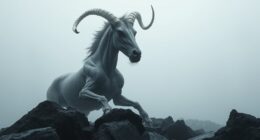Across the globe, stories of shape-shifting beings reveal a fascinating cultural tapestry. European folklore links witches transforming into cats, reflecting fears and societal tensions of past eras. In contrast, Asian legends often feature tigers and fox spirits that change form to symbolize power, protection, or warnings. These tales embody humanity’s intrigue with transformation, the unknown, and spiritual mastery. Exploring these stories shows how cultures shape and adapt shapeshifter myths—uncover more to see how these legends evolve worldwide.
Key Takeaways
- European legends connect witches transforming into cats during witch hunts, symbolizing malevolence and societal fears.
- Asian folklore features shape-shifting tigers and felines representing strength, protection, and spiritual mastery.
- Transformation stories reflect cultural values, societal fears, and beliefs about supernatural powers across regions.
- Shape-shifting beings symbolize power, mystery, and duality, embodying both divine and malevolent qualities.
- The global lore illustrates humanity’s fascination with transformation, identity fluidity, and the supernatural across diverse cultures.

Throughout history, the myth of the werecat has fascinated cultures around the world, evolving from European legends of witches transforming into cats to Asian folklore featuring shape-shifting tigers. These stories often center on the idea of shape shifting origins, where humans are believed to possess the ability to transform into feline creatures. In European traditions, this transformation was frequently linked to witches who would take the form of cats to carry out their dark deeds, especially during the witch hunts of the Middle Ages. These shape shifting origins served as a way to explain mysterious behaviors, nocturnal prowling, or sudden disappearances, casting the feline form as both a symbol of power and malevolence. The cultural symbolism attached to these shape-shifting beings often reflected societal fears: witches as outsiders, evil forces, or agents of chaos. The cat, with its mysterious behavior and nocturnal nature, became a potent emblem of the unknown, embodying both spiritual and supernatural significance.
In Asian cultures, the lore takes a different but equally compelling turn. Here, shape-shifting tigers or other large felines often symbolize strength, protection, or spiritual transformation. For example, in Chinese mythology, the huli jing or fox spirits can transform into beautiful women, but stories also depict tigers shifting forms in ways that symbolize the fluidity between the mortal and spiritual worlds. These shape-shifting origins emphasize not only transformation but also the potential for both harm and blessing. The cultural symbolism in Asian folklore tends to be more nuanced, often representing the duality of nature—where a creature’s shape-shifting ability signifies mastery over change, power, or the divine. Such stories serve as allegories for personal growth, spiritual enlightenment, or the unpredictable forces of nature. Moreover, recent studies highlight how material and cultural influences shape the narratives and symbolism associated with these shapeshifters, reflecting evolving societal values and beliefs.
As you explore these varied traditions, you’ll notice that the core idea of shape shifting origins links deeply to the human fascination with transformation and the mysterious. Whether as a tool of witches or a symbol of spiritual prowess, these shapeshifters embody the fluidity of identity and the power to cross boundaries—be they physical, spiritual, or societal. Their cultural symbolism reveals much about the values and fears of different societies, illustrating how shape-shifting stories are not just about mystical creatures but also about human desires for change, control, and understanding the unknown. Through these tales, you see how the myth of the werecat reflects universal themes of transformation, mystery, and the complex relationship between humans and the natural or supernatural worlds.
Frequently Asked Questions
Are Werecats Considered Real Animals or Mythical Creatures?
Werecats are considered mythical creatures, not real animals. You see, they stem from shape-shifting myths across different cultures, often blending feline symbolism with supernatural powers. These stories portray humans transforming into cats or feline-like beings, embodying mystery and magic. While they capture your imagination, there’s no scientific evidence that werecats exist outside of folklore, making them fascinating legends rooted in cultural beliefs and symbolic feline traits.
How Do Cultural Perceptions of Werecats Differ Worldwide?
You might be surprised, but over 60% of cultures see werecats as both feared and revered symbols. Cultural symbolism varies widely, with European folklore often portraying werecats as cursed creatures or witches’ allies, while Asian folklore depicts them as powerful, mystical guardians. These folklore variations reflect deep cultural beliefs about transformation, power, and morality, shaping how different societies perceive these enigmatic creatures.
What Are Common Werecat Symbols in Folklore?
You’ll notice that common werecat symbols in folklore often include claws, eyes, and feline footprints, representing mythical transformations and feline symbolism. These symbols reflect the mysterious and supernatural nature of werecats, emphasizing their agility, stealth, and duality. In many cultures, the cat’s eyes symbolize hidden knowledge, while claws suggest danger or protection. These symbols serve as powerful reminders of the werecat’s elusive, mystical essence across various legends worldwide.
Are There Modern Sightings or Reports of Werecats?
You might be surprised to learn that over 200 cryptid sightings, including werecats, are reported annually worldwide. In urban legends, these mysterious creatures often appear in rural or forested areas, but modern sightings still pop up in cities and suburbs. While skeptics dismiss them as hoaxes or misidentifications, believers swear they’ve seen these elusive feline beings prowling under moonlight, fueling ongoing fascination with the idea of modern werecats lurking among us.
How Do Werecat Legends Influence Contemporary Pop Culture?
Werecat legends heavily influence pop culture today, shaping werecat symbolism in movies, TV shows, and books. You see werecats depicted as mysterious, powerful beings, often embodying duality and transformation. These pop culture references make the legend more relatable and intriguing, inspiring costume designs, video games, and comics. By highlighting their supernatural traits, they keep the myth alive, fascinating audiences and fueling curiosity about the mysterious world of werecats.
Conclusion
Throughout history, werecat legends reveal that curiosity killed the cat, yet these stories also show their enduring mystique. From European witches to Asian tigers, you see how different cultures interpret shapeshifting lore, blending fear and fascination. These tales remind you that every culture has its own way of explaining the unknown. Remember, the more things change, the more they stay the same—our fascination with mysterious creatures continues to thrive across the ages.










